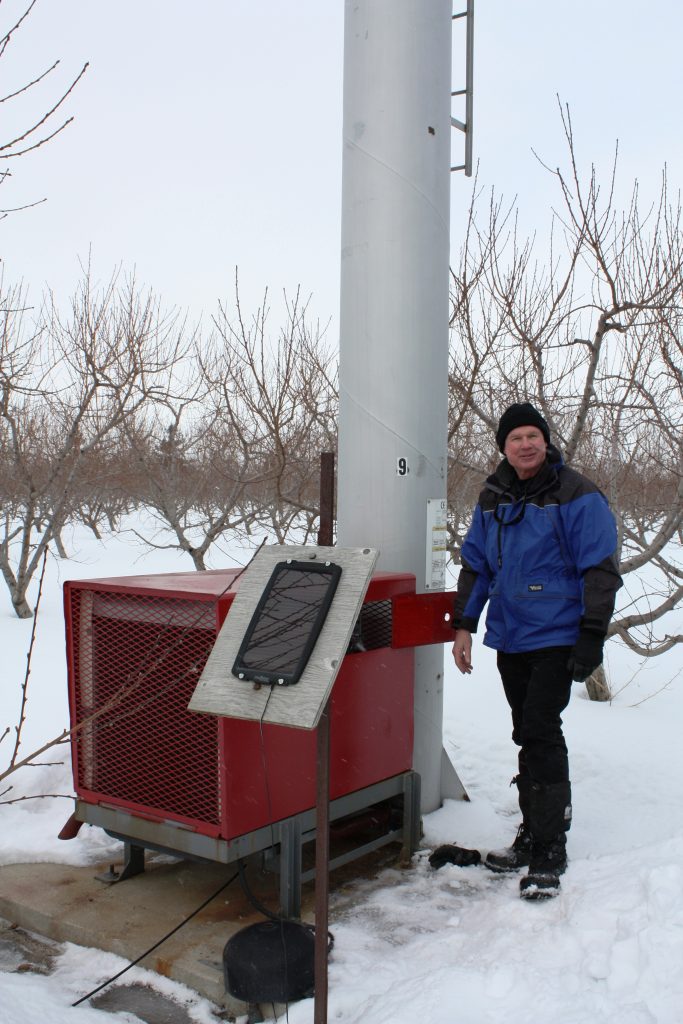
Features
Business
Policy
Automated weather alert system helps tender fruit farmers mitigate winter damage
August 5, 2015 By Lilian Schaer / AgInnovation Ontario
 Phil Tregunno in his orchard. AgInnovation Ontario / Agricultural Adaptation Council..
Phil Tregunno in his orchard. AgInnovation Ontario / Agricultural Adaptation Council..
August 5, 2015 – A new website is helping tender fruit growers monitor the cold hardiness of their buds over the winter months and manage possible winter injury.
Growers can register on www.tenderfruitalert.ca to receive free email alerts about potential low temperature situations that can help them make decisions about when they should use tools like frost fans and wind machines to protect against the weather.
The online, automated weather alert system was launched by Ontario Tender Fruit as part of a project funded through Growing Forward 2 so growers can better mitigate climate-induced damage to their orchards and crops. Ontario’s tender fruit crops include peaches, nectarines, cherries, apricots, and plums.
“In 2012, we had a warm spring followed by a cold spell that killed a lot of blossoms, and we had no real data on what was happening in the field,” says Ontario Tender Fruit Chair Phil Tregunno, who farms near Niagara-on-the-Lake. “We knew we needed more information on when we can expect damage to our blossoms so that we can do a better job at managing our farms, from when to turn on wind machines to adjusting management practices in the orchard.”
The bud cold hardiness tool developed as part of the project provides information about the survivability of buds and lets growers know at what temperatures they could lose 10 per cent, 50 per cent, or even 90 per cent of their buds.
Having a sense of expected damage levels will help farmers with planning their upcoming growing season, from how many workers to hire and what volume of crop they could expect to market, to how much fertilizer to apply and what type of pruning strategies to use.
Consulting firm KCMS started collecting data in 2013 by regularly visiting a variety of orchards in the province’s major tender fruit growing areas to gather buds from different tender fruit crops and testing them to look for the effects of temperature throughout winter and early spring.
“We expose the buds to controlled freezing down to -40C, doing our best to replicate field conditions. When the water in the bud cells freezes, it generates a heat spike on our graphs so we know when damage occurs and lets us calculate different lethal temperature ratings,” explains Ryan Brewster of KCMS. “Without this technology, there is a lot of guessing. Growers do have past history, but this data is a snapshot in time of exactly what is happening.”
The bud data is combined with wind speed and temperature data collected from various sites that are part of the Weather INnovations (WIN) network of monitoring stations; together, this information is used to help generate the automated alerts to growers when necessary. A final assessment of winter damage is a blossom count conducted in the spring.
The current project will run until 2017, but it’s a long-term initiative designed to better equip growers to handle climate change challenges. This includes being able to plant hardier tender fruit varieties in areas that are more vulnerable to cold temperatures, and knowing where to best place wind machines.
This project was supported in part through Growing Forward 2 (GF2), a federal-provincial-territorial initiative. The Agricultural Adaptation Council assists in the delivery of GF2 programs in Ontario.
“Funding like this is all-important. We’re a small industry and you couldn’t do this on your own as an individual grower without support,” says Tregunno. “It’s critical to the buy local movement and the local tourism industry, and we’re lucky to be able to work through government like this.”
Print this page